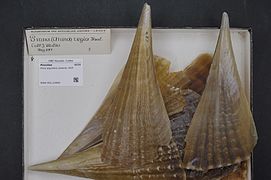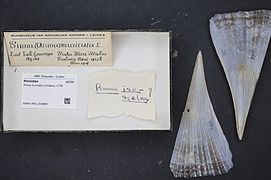Pinna (bivalve)
| Pinna Temporal range: [1]
| |
|---|---|

| |
| Pinna nobilis | |
| Scientific classification | |
| Domain: | Eukaryota |
| Kingdom: | Animalia |
| Phylum: | Mollusca |
| Class: | Bivalvia |
| Order: | Pteriida |
| Superfamily: | Pinnoidea |
| Family: | Pinnidae |
| Genus: | Pinna Linnaeus, 1758 |
| Type species | |
| Pinna rudis Linnaeus, 1758 | |
| Synonyms | |
| |
Pinna is a genus of bivalve molluscs belonging to the family Pinnidae.[2]
The type species of the genus is Pinna rudis.
The most completely studied species in the genus is P. nobilis, a Mediterranean pen shell which was historically important as the principal source of sea silk.
Description[edit]


These pen shells can reach a length of about 80–90 cm (31–35 in). They are characterized by thin, elongated, wedge-shaped, and almost triangular shells with long, toothless edges. The surface of the shells shows radial ribs over their entire length.
Pinna is distinguished from its sibling genus Atrina by the presence of a sulcus dividing the nacreous region of the valves, and the positioning of the adductor scar on the dorsal side of shells.
These bivalves most commonly lie point-first on the sea bottom in which they live, anchored by a net of byssus threads.
Distribution[edit]
Species in the genus Pinna are geographically widespread. This genus is very ancient, going back up to the Carboniferous period. It is especially represented in Jurassic and Cretaceous fossils.[1]
Species[edit]
According to the World Register of Marine Species, species in the genus Pinna include:[3]
- † Pinna affinis J. Sowerby, 1821 †
- Pinna angustana Lamarck, 1819
- † Pinna arcuata J. Sowerby, 1821
- Pinna atropurpurea Sowerby, 1825
- Pinna attenuata Reeve, 1858
- Pinna bichi Thach, 2016
- Pinna bicolor Gmelin, 1791
- Pinna carnea Gmelin, 1791
- Pinna cellophana Matsukuma & Okutani, 1986
- Pinna deltodes Menke, 1843
- † Pinna dissimilicostata X.-M. Gan, 1978
- † Pinna distans Hutton, 1873
- Pinna dolabrata Lamarck, 1819
- Pinna electrina Reeve, 1858
- Pinna epica Jousseaume, 1894
- Pinna exquisita Dall, Bartsch & Rehder, 1938
- Pinna fimbriatula Reeve, 1859
- † Pinna folium Young & Bird, 1822
- † Pinna huiyangensis R.-J. Zhang, 1977
- Pinna incurva Gmelin, 1791
- † Pinna kawhiana Marwick, 1953
- † Pinna keexwaanensis McRoberts, 2017
- † Pinna lanceolata J. Sowerby, 1821
- † Pinna lata Hutton, 1873 (taxon inquirendum)
- Pinna linguafelis (Habe, 1953)
- Pinna madida Reeve, 1858
- Pinna menkei Reeve, 1858
- † Pinna mitis Phillips, 1829
- † Pinna muikadanensis Nakazawa, 1961
- Pinna muricata Linnaeus, 1758
- Pinna nobilis Linnaeus, 1758 -- Grande nacre
- † Pinna nyainrongensis S.-X. Wen, 1979
- † Pinna octavia Marwick, 1953
- † Pinna pacata Shilekhin, Mazaev & Biakov, 2023 [4]
- Pinna papyracea Gmelin, 1791
- † Pinna plicata Hutton, 1873 (Based on a fragment of a trace fossil called Zoophycus)
- Pinna rapanui Araya & Osorio, 2016
- Pinna rudis Linnaeus, 1758
- Pinna rugosa Sowerby, 1835
- Pinna sanguinolenta Reeve, 1858
- † Pinna socialis d'Orbigny, 1850
- † Pinna subcuneata Eichwald, 1865
- † Pinna suprajurensis d'Orbigny, 1850
- Pinna trigonalis Pease, 1861
- Pinna trigonium Dunker, 1852
- Pinna wayae Schultz & M. Huber, 2013
Nomen nudum[edit]
- Pinna inflata Röding, 1798
- Pinna lubrica Lightfoot, 1786
- Pinna nebulosa Lightfoot, 1786
- Pinna nigricans Lightfoot, 1786
- Pinna striata Röding, 1798
- Pinna tenera Lightfoot, 1786
- Pinna violacea Röding, 1798
Nomen dubium[edit]
- Pinna atrata Clessin, 1891
- Pinna bullata Gmelin, 1791
- Pinna marginata Lamarck, 1819
- Pinna minax Hanley, 1858
- Pinna rollei Clessin, 1891
- Pinna rostellum Hanley, 1858
- Pinna rotundata Linnaeus, 1758
- Pinna sanguinea Gmelin, 1791
- Pinna virgata Menke, 1843
Synonyms[edit]
- Pinna squamosissima Philippi, 1849: synonym of Atrina serrata (G. B. Sowerby I, 1825)
- Pinna strangei Reeve, 1858: synonym of Atrina strangei (Reeve, 1858)
- Pinna stutchburii Reeve, 1859: synonym of Pinna attenuata Reeve, 1858
- Pinna subviridis Reeve, 1858: synonym of Atrina seminuda (Lamarck, 1819)
- Pinna tasmanica Tenison-Woods, 1876: synonym of Atrina tasmanica (Tenison Woods, 1876)
- Pinna truncata Philippi, 1844: synonym of Atrina fragilis (Pennant, 1777)
- Pinna tuberculosa Sowerby, 1835: synonym of Atrina tuberculosa (G. B. Sowerby I, 1835)
- Pinna varicosa Lamarck, 1819: synonym of Pinna carnea Gmelin, 1791
- Pinna vespertina Reeve, 1858: synonym of Pinna atropurpurea G. B. Sowerby I, 1825
- Pinna vexillum Born, 1778: synonym of Atrina vexillum (Born, 1778)
- Pinna vitrea Gmelin, 1791: synonym of Streptopinna saccata (Linnaeus, 1758)
- Pinna vulgaris Roissy, 1804: synonym of Pinna nobilis Linnaeus, 1758
- Pinna whitechurchi Turton, 1932: synonym of Atrina squamifera (G. B. Sowerby I, 1835)
- Pinna zebuensis Reeve, 1858: synonym of Pinna muricata Linnaeus, 1758
- Pinna zelandica Gray, 1835: synonym of Atrina zelandica (Gray, 1835)
References[edit]
- ^ a b Genus Pinna at Paleobiology Database
- ^ MolluscaBase eds. (2022). MolluscaBase. Pinna Linnaeus, 1758. Accessed through: World Register of Marine Species at: https://www.marinespecies.org/aphia.php?p=taxdetails&id=138352 on 2022-01-16
- ^ WoRMS Editorial Board (2018). "Taxonomy". Pinna Linnaeus, 1758. doi:10.14284/170. Retrieved 2018-12-31.
{{cite book}}:|website=ignored (help) - ^ Shilekhin, L. E.; Mazaev, A. V.; Biakov, A. S. (2023). "The most ancient representatives of the genus Pinna (Bivalvia) in the Early Permian reef of Shakhtau (southern Cis-Urals, Russia)". Paleontological Journal. 57 (4): 21–25.
- Frank H.T. Rodes, Herbert S. Zim en Paul R. Shaffer (1993) - Natuurgids Fossielen (het ontstaan, prepareren en rangschikken van fossielen), Zuidnederlandse Uitgeverij N.V., Aartselaar. ISBN D-1993-0001-361
- Cyril Walker & David Ward (1993) - Fossielen: Sesam Natuur Handboeken, Bosch & Keuning, Baarn. ISBN 90-246-4924-2
- Packard, Earl; Jones, David L. (Sep 1965). "Cretaceous Pelecypods of the Genus Pinna from the West Coast of North America". Journal of Paleontology. 39 (1): 910–915.
- "Glossary". Man and Mollusc. Retrieved 2008-01-30.
- Coan, E. V.; Valentich-Scott, P. (2012). Bivalve seashells of tropical West America. Marine bivalve mollusks from Baja California to northern Peru. 2 vols, 1258 pp.
- Schultz, P. W.; Huber, M. (2013). Revision of the worldwide Recent Pinnidae and some remarks of fossil European Pinnidae. Acta Conchyliorum. 13: 1–164.
External links[edit]
- Linnaeus, C. (1758). Systema Naturae per regna tria naturae, secundum classes, ordines, genera, species, cum characteribus, differentiis, synonymis, locis. Editio decima, reformata
- Mörch, O. A. L. (1852-1853). Catalogus conchyliorum quae reliquit D. Alphonso d'Aguirra & Gadea Comes de Yoldi, Regis Daniae Cubiculariorum Princeps, Ordinis Dannebrogici in Prima Classe & Ordinis Caroli Tertii Eques. Fasc. 1, Cephalophora, 170 pp. [1852]; Fasc. 2, Acephala, Annulata, Cirripedia, Echinodermata, 74 [+2] pp. [1853]. Hafniae [Copenhagen]: L. Klein
- Children J. G. (1822-1823). Lamarck's genera of shells. Quarterly Journal of Science, Literature and the Arts (London), 14(27): 64-87, pl. 3-4 [ottobre 1822]; 14(28): 298-322, pl. 5-6 [gennaio 1823]; 15(29): 23-52, pl. 2-3 [aprile 1823]; 15(30): 216-258, pl. 7-8 [luglio 1823]; 16 (31): 49-79, pl. 5 [ottobre 1823]; 16 (32): 241-264, pl. 6 [dicembre 1823]. [Vedi anche Kennard, Salisbury & Woodward, 1931],













